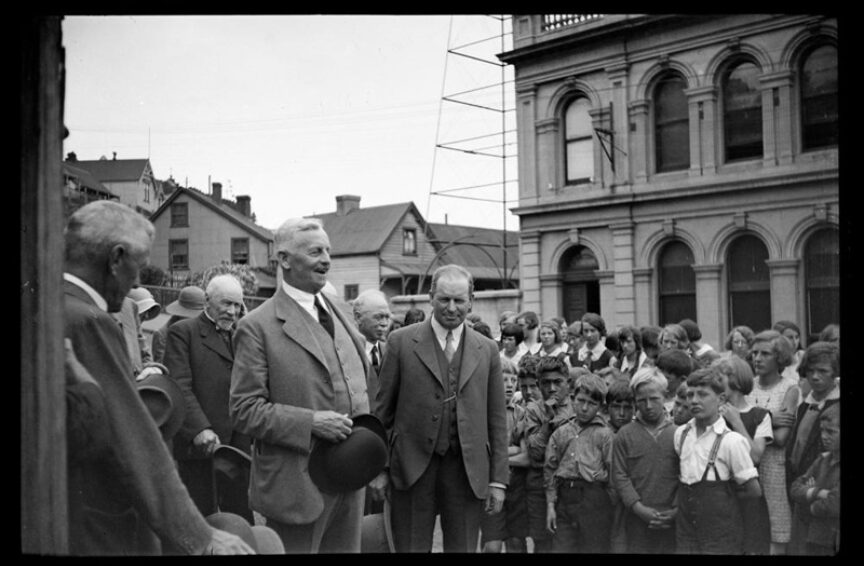PO Box 95
Lyttelton 8841
Te Ūaka recognises Te Hapū o Ngāti Wheke as Mana Whenua and Mana Moana for Te Whakaraupō / Lyttelton Harbour.
Jean Batten Visits Lyttelton
In early May 1937, Ōhinehou Lyttelton was treated to a visit by one of the greatest international aviators of the era, New Zealander Jean Batten. By the expressions on the faces in our main photo, the throng of young girls were clearly delighted to be in the presence of the aviatrix. The second photo depicts a densely packed crowd on the waterfront, the vast majority donning hats, as was the norm in days when one wasn’t fully dressed without a head covering of some description!
Jane Gardner Batten (soon known as Jean) was born in Rotorua on 15 September 1909. Her parents' marriage did not survive the estrangement of the war years and the couple separated after her father’s return from the Western Front. Batten’s mother was an influential force in her life; a strong feminist, she instilled in her daughter a belief in her potential to achieve in male dominated arenas and inspired her fascination with flying from an early age – it is said that she pinned a newspaper image of the French pilot Louis Blériot beside Jean’s cot.
After her school years, Batten began training as a secretary and studied piano and ballet, but these traditional activities were soon superseded by a growing ambition to fly. Her mother supported this desire; they travelled to England together where Batten trained as a pilot at the London Aeroplane Club. With funds acquired from an admirer, she then completed the 100 hours required for commercial pilot’s training. She was also gifted a de Havilland Gipsy Moth by another young man infatuated by the determined young woman.
Batten’s early flying career was motivated by a desire to break the Englishwoman, Amy Johnson’s, record of 19 and a half days for a solo flight from England to Australia. Her first attempt was marred by weather and engine trouble, resulting in the wreck of her plane, although she escaped uninjured. Back in England she managed to secure another patron and another Gipsy Moth, but this attempt was also unsuccessful and ended in a severe crash in which she sustained facial injuries. Undeterred, she was finally successful in May 1934 with a record breaking solo flight of just over 14 days 22 hours, smashing Jonhsons’s record by 5 days. After a publicity tour of Australia and New Zealand, in April 1935 she flew the same plane back to England, thus becoming the first woman to complete the journey both ways.
Many more flying achievements followed; in November 1935, now in a Percival Gull Six, she made the fastest trip in any plane (and was the first woman) to complete the flight from England to Brazil (including the fastest crossing of the South Atlantic). In October 1936 she flew from England to New Zealand in just over 11 days, a record that was unbroken for the next 44 years. Her last major solo flight from Australia to England in October 1937, was another record breaking trip of just 5 days, 18 hours and 15 minutes.
Rapturous welcomes, huge public admiration and many awards were showered on Batten; she was an exceptional navigator and seemed fearless and resilient. That she was also beautiful and glamorous only strengthened her appeal. Amidst the flurry of international accolades, in New Zealand there was even a shoe named after her – “Ladies ‘Jean Batten’ shoe in brown suede, laced, slashed tongue. Rubber sole and heel.”
With her dark hair, porcelain skin and a slim frame, her fame, and her somewhat troubled and reclusive nature, Jean Batten was referred to as “The Garbo of the Skies” by writer Ian MacKersey, author of a definitive biography of that name (Warner Books, 1992).
Batten’s life was not without controversy; some found her difficult, self absorbed and mercenary in pursuit of her ambitions. She disappeared from public view for extended periods of time and suffered several breakdowns – this was especially severe after the death of her mother when they were living together in Tenerife in the 1960s.
Batten herself died in obscurity aged 73, of complications from an untreated dog bite. She was buried in an unmarked pauper's grave in Palma Cemetery, Majorca; her fate unknown for 5 years due to a failure of bureaucracy in notifying her next of kin. In 1988 a more fitting bronze plaque was placed at her gravesite, acknowledging her position as “the finest woman pilot of the golden age of aviation”.
See also https://teara.govt.nz/en/biographies/4b13/batten-jean-gardner

